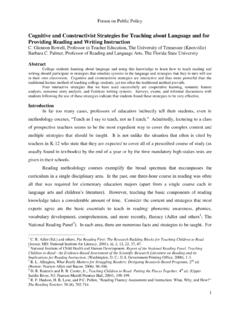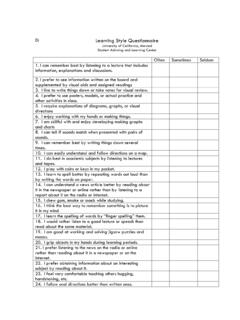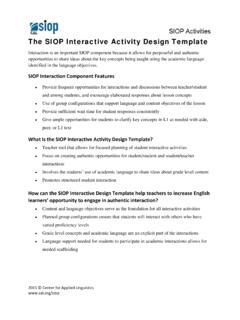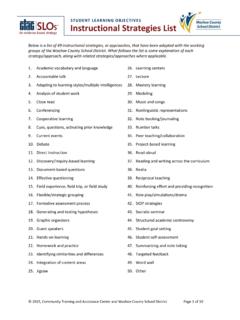Transcription of Portfolio Artifact Suggestions - American University
1 Portfolio Artifact Suggestions This is a living document and will be updated periodically. This is not a complete list but some Suggestions . If you have any questions, please consult your supervisor. INTASC Standards Artifact Suggestions The Learner and Learning Standard #1: Learner Development: The teacher understands how learners grow and develop, recognizing that patterns of learning and development vary individually within and across the cognitive, linguistic, social, emotional, and physical areas, and designs and implements developmentally appropriate and challenging learning experiences.
2 Lesson plans showing different developmental levels Photos of students doing age-appropriate, hands on learning Lesson plans that allow students use multiple intelligences Highlighting an instructional strategy that is age appropriate. For instance, teaching a writing lesson to Kindergartners looks very different than teaching a lesson to 5th graders and 10th graders. Standard #2: Learning Differences: The teacher uses understanding of individual differences and diverse cultures and communities to ensure inclusive learning environments that enable each learner to meet high standards.
3 Conference notes from IEP meeting Lesson plan showing adaptations for a child with learning disabilities Student work or lessons illustrating how you adapted for student with advanced abilities Graphic organizers used with students Manipulatives to use in effectively teaching a math concept English Language Learner (ELL) adaptation Sample lesson plan including several reading strategies Differentiated lesson plan Observation of a Reader (Elementary reading Methods) INTASC Standards Artifact Suggestions Standard #3: Learning Environments: The teacher works with others to create environments that support individual and collaborative learning, and that encourage positive social interaction, active engagement in learning, and self-motivation.
4 Copy of discipline plan Examples of items you created to motivate students (awards/competitions/etc.) Classroom Management Plan Photographs of bulletin boards/projects Weekly Classroom Meetings Classroom Rules and Expectations Teacher (candidate)-made classroom centers Morning Meeting Activities Different seating arrangements for different lessons/activities Instructional strategies (lots of cooperative learning ones) that illustrate positive social interaction, engagement in learning and self-motivation Content Knowledge Standard #4: Content Knowledge.
5 The teacher understands the central concepts, tools of inquiry, and structures of the discipline(s) he or she teaches and creates learning experiences that make these aspects of the discipline accessible and meaningful for learners to assure mastery of the content. Unit Plan, focusing on content History of Math assignment (Math Methods) Guided reading lessons Social Studies or Science lessons that required the teacher to do his/her own research to make something accessible to students Math lessons where multiple approaches to solving problems were presented INTASC Standards Artifact Suggestions Standard #5: Application of Content.
6 The teacher understands how to connect concepts and use differing perspectives to engage learners in critical thinking, creativity, and collaborative problem solving related to authentic local and global issues. Lessons connected to global issues (ex: recycling, pollution, deforestation, etc.) STEM activities Mathematical Misconceptions Assignment (Math Methods) Artifacts showing students working together to solve authentic issues that arose in the classroom (Morning Meeting, etc.) In-class debates, related to the topic learned in class and how it relates to today.
7 Instructional Practice Standard #6: Assessment: The teacher understands and uses multiple methods of assessment to engage learners in their own growth, to monitor learner progress, and to guide the teacher and learner s decision-making. Impact of Student Learning (K-12 Required, Secondary Education Methods) Running Record assessments Teacher (candidate)-made rubric Formal assessment tools used Teacher (candidate)-made test Alternative assessment methods/testing modifications Pre/post tests developed Informal assessments Exit slips Standard #7: Planning for Instruction.
8 The teacher plans instruction that supports every student in meeting rigorous learning goals by drawing upon knowledge of content areas, curriculum, cross-disciplinary skills, and pedagogy, as well as knowledge of learners and the community context. Lesson plans specifically addressing a standard or concept Cross-curricular unit plans Interdisciplinary Thematic Unit Schedule from student teaching experience Pre/Post assessments and related lessons Class academic projects Using multiple strategies to teach the same standard/objectives Data collection tools jigsaw activity INTASC Standards Artifact Suggestions Standard #8: Instructional Strategies.
9 The teacher understands and uses a variety of instructional strategies to encourage learners to develop deep understanding of content areas and their connections, and to build skills to apply knowledge in meaningful ways. Video of yourself teaching a lesson (Required) Examples of higher order thinking activities Examples of scaffolding instruction An inquiry-based lesson A cooperative learning lesson Using technology interactively Professional Responsibility Standard #9: Professional Learning and Ethical Practice: The teacher engages in ongoing professional learning and uses evidence to continually evaluate his/her practice, particularly the effects of his/her choices and actions on others (learners, families, other professionals, and the community), and adapts practice to meet the needs of each learner.
10 Critical Reflection Paper (Student Teaching Seminar) Handouts from Professional Development Workshops Staff Meeting notes or handouts Student reflection from The Lesson Plan Analysis and Implementation Observation Standard #10: Leadership and Collaboration: The teacher seeks appropriate leadership roles and opportunities to take responsibility for student learning, to collaborate with learners, families, colleagues, other school professionals, and community members to ensure learner growth, and to advance the profession. Parent Conference Assignment (Student Teaching Seminar) Classroom or school visits from members of the community (ex: Mad Science Assembly, school visit by an author, etc.)







